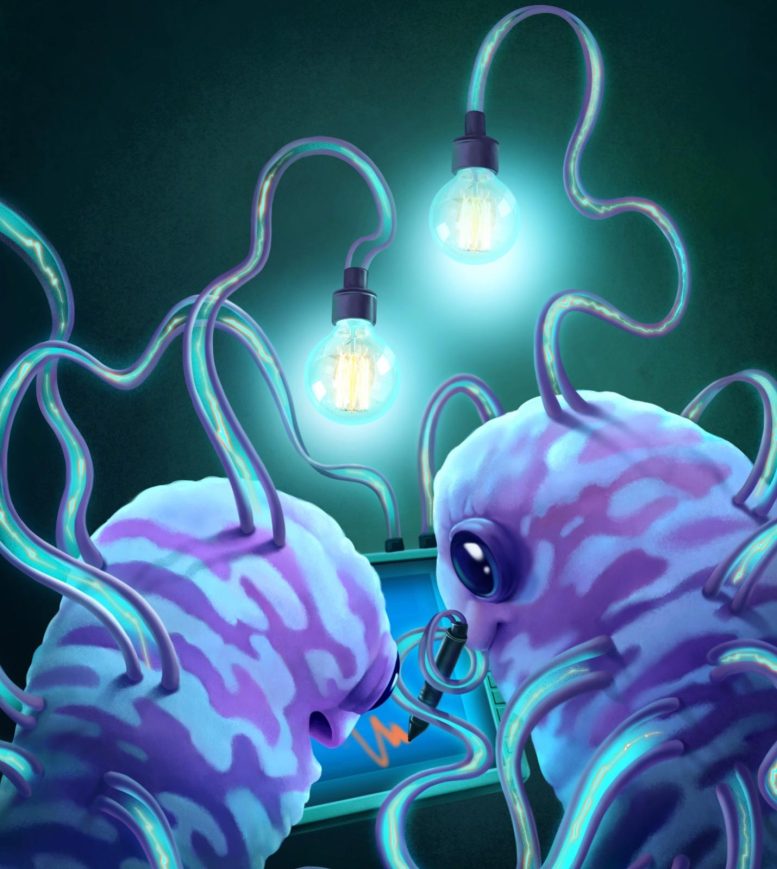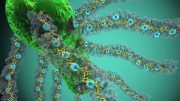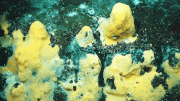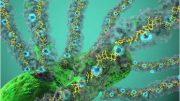
“Nanowires” produced by Geobacter in response to an electric field applied to electricity-producing biofilms. These nanowires are composed of cytochrome OmcZ and show 1000-fold higher conductivity and 3-times higher stiffness than the nanowires of cytochrome OmcS important in natural environments, allowing bacteria to transport electrons over 100-times their size. Credit: Sibel Ebru Yalcin. Design: Ella Maru Studio
An ultra-stable protein nanowire made by bacteria provides clues to combating climate change.
Rapid global warming poses a severe and immediate threat to life on Earth. Rising temperatures are caused in part by atmospheric methane, which is 30 times more potent than CO2 at trapping heat. Microbes produce half of this methane and as temperatures continue to rise, microbial growth is accelerated, leading to a higher production of greenhouse gases than can be absorbed by plants. This weakens the Earth’s ability to act as a carbon sink and contributes to a rise in global temperatures.
A potential solution to this vicious circle could be another kind of microbe that eats up to 80% of methane flux from ocean sediments that protect the Earth. How microbes serve as both the biggest producers as well as consumers of methane has remained a mystery because they are very difficult to study in the laboratory. In the journal Nature Microbiology, surprising wire-like properties of a protein highly similar to the protein used by methane-eating microbes are reported by a Yale University team led by Yangqi Gu, and Nikhil Malvankar, of Molecular Biophysics and Biochemistry at Microbial Sciences Institute.
The team had previously shown that this protein nanowire shows the highest conductivity known to date, allowing the generation of the highest electric power by any bacteria. But to date, no one had discovered how bacteria make them and why they show such extremely high conductivity.
Using cryo-electron microscopy, Yangqi and the team were able to see the nanowire’s atomic structure and discover that hemes packed closely to move electrons very fast with ultra-high stability. It also explains how these bacteria can survive without oxygen-like membrane-ingestible molecules and form communities that can send electrons over 100 times bacterial size. Yangqi and the team also built nanowires synthetically to explain how bacteria make nanowires on demand.
“We are using these heme wires to generate electricity and to combat climate change by understanding how methane-eating microbes use similar heme wires,” Malvankar said.
Reference: “Structure of Geobacter cytochrome OmcZ identifies mechanism of nanowire assembly and conductivity” by Yangqi Gu, Matthew J. Guberman-Pfeffer, Vishok Srikanth, Cong Shen, Fabian Giska, Kallol Gupta, Yuri Londer, Fadel A. Samatey, Victor S. Batista and Nikhil S. Malvankar, 2 February 2023, Nature Microbiology.
DOI: 10.1038/s41564-022-01315-5
Other authors are Malvankar Lab Members Matthew Guberman-Pfeffer, Vishok Srikanth, Cong Shen, Yuri Londer, Fadel Samatey with collaborators Prof. Victor Batista, Prof. Kallol Gupta, and Fabian Giska.









“Rapid global warming poses a severe and immediate threat to life on Earth.”
That is a strong, overly broad assertion for which the facts are not in evidence. I think that the authors should stick to what their research claims to have discovered, and not try to interpret something they haven’t studied.
“… atmospheric methane, which is 30 times more potent than CO2 at trapping heat.” Actually the IPCC states the value is 28 to 36X. Atmospheric concentrations of GHGs and their rates of change (flux) are commonly reported as mole fractions, allowing a comparison of the relative molecular abundance. What they neglected to say is that the CO2 equivalence is for an equal weight of methane. When corrected for the large difference in molecular weight, the molecule-to-molecule long-term potential for methane warming is only about 10X that of CO2. Furthermore, the total amount of methane in the atmosphere is less than 2ppmv and it is increasing at a rate of about 0.009ppmv/yr. For context, CO2 has an atmospheric concentration of about 420ppmv, and is increasing currently at a rate of about 2.8ppmv/year. Even allowing for the greater warming potential equivalence, the annual increase in methane is of the same order of magnitude as the least precise significant figure of the CO2 measurements at Mauna Loa Observatory.
“A potential solution to this vicious circle could be another kind of microbe that eats up to 80% of methane flux from ocean sediments that protect the Earth.” What protects the Earth? Ocean sediments? How did this poorly written sentence make it through peer review?